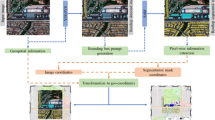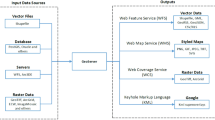Abstract
This work describes algorithms for performing discrete object detection, specifically in the case of buildings, where usually only low quality RGB-only geospatial reflective imagery is available. We utilize new candidate search and feature extraction techniques to reduce the problem to a machine learning (ML) classification task. Here we can harness the complex patterns of contrast features contained in training data to establish a model of buildings. We avoid costly sliding windows to generate candidates; instead we innovatively stitch together well known image processing techniques to produce candidates for building detection that cover 80–85 % of buildings. Reducing the number of possible candidates is important due to the scale of the problem. Each candidate is subjected to classification which, although linear, costs time and prohibits large scale evaluation. We propose a candidate alignment algorithm to boost classification performance to 80–90 % precision with a linear time algorithm and show it has negligible cost. Also, we propose a new concept called a Permutable Haar Mesh (PHM) which we use to form and traverse a search space to recover candidate buildings which were lost in the initial preprocessing phase. All code and datasets from this paper are made available online (http://kdl.cs.umb.edu/w/datasets/ and https://github.com/caitlinkuhlman/ObjectDetectionCLUtility).
















Similar content being viewed by others
References
Baltsavias EP (2004) Object extraction and revision by image analysis using existing geodata and knowledge: current status and steps towards operational systems. ISPRS J Photogramm Remote Sens 58(3):129–151
Bay H, Tuytelaars T, Van Gool L (2006) Surf: Speeded up robust features. In: Computer vision ECCV 2006, pp 404–417. Springer
Bonnefon R, Dherete P, Desachy J (2002) Geographic information system updating using remote sensing images. Pattern Recogn Lett 23(9):1073–1083
Breiman L (2001) Random forests. Mach Learn 45(1):5–32
Brunner D, Lemoine G, Bruzzone L (2010) Earthquake damage assessment of buildings using VHR optical and SAR imagery. IEEE Trans Geosci Remote Sens 48(5):2403–2420
Canny J (1986) A computational approach to edge detection. IEEE Trans Pattern Anal Mach Intell 6:679–698
Chang F, Chen C-J, Lu C-J (2004) A linear-time component-labeling algorithm using contour tracing technique. Comput Vis Image Underst 93(2):206–220
Cohen JP, Ding W (2013) Crater detection via genetic search methods to reduce image features. Adv Space Res 53(12):1768–1782. doi:10.1016/j.asr.2013.05.010
Cortes C, Vapnik V (1995) Support-vector networks. Mach Learn 20(3):273–297
Dong L, Shan J (2013) A comprehensive review of earthquake-induced building damage detection with remote sensing techniques. ISPRS J Photogramm Remote Sens 84:85–99
Druaguct L, Blaschke T (2006) Automated classification of landform elements using object-based image analysis. Geomorphology 81(3):330–344
Freund Y, Schapire RE (1996) Experiments with a New Boosting Algorithm
Irvin RB, McKeown DM (1989) Methods for exploiting the relationship between buildings and their shadows in aerial imagery. In: OE/LASE’89, 15–20 Jan., Los Angeles. CA, pp 156–164
John GH, Langley P (1995) Estimating continuous distributions in bayesian classifiers. In: Proceedings of the eleventh conference on uncertainty in artificial intelligence, UAI’95. Morgan Kaufmann Publishers Inc., San Francisco, CA, USA, pp 338–345
Karantzalos K, Paragios N (2009) Recognition-driven two-dimensional competing priors toward automatic and accurate building detection. IEEE Trans Geosci Remote Sens 47(1):133–144
Lin C, Nevatia R (1998) Building detection and description from a single intensity image. Comput Vis Image Underst 72(2):101–121
Lowe DG (2004) Distinctive image features from scale-invariant keypoints. Int J Comput Vis 60(2):91–110
Mayer H (1999) Automatic object extraction from aerial imagery: a survey focusing on buildings. Comput Vis Image Underst 74(2):138–149
Mnih V, Hinton GE (2010) Learning to detect roads in high-resolution aerial images. In: Computer visionECCV 2010, pp 210–223. Springer
Mountrakis G, Im J, Ogole C (2011) Support vector machines in remote sensing: a review. ISPRS J Photogramm Remote Sens 66(3):247–259
Ok AO (2013) Automated detection of buildings from single VHR multispectral images using shadow information and graph cuts. ISPRS J Photogramm Remote Sens 86:21–40
Quinlan JR (1993) C4.5: Programs for machine learning. Morgan Kaufmann Publishers Inc., San Francisco
Simonetto E, Oriot H, Garello R (2005) Rectangular building extraction from stereoscopic airborne radar images. IEEE Trans Geosci Remote Sens 43(10):2386–2395
Sirmacek B, Unsalan C (2011) A probabilistic framework to detect buildings in aerial and satellite images. IEEE Trans Geosci Remote Sens 49(1):211–221
Sohn G, Dowman I (2007) Data fusion of high-resolution satellite imagery and liDAR data for automatic building extraction. ISPRS J Photogramm Remote Sens 62(1):43–63
Viola P, Jones MJ (2004) Robust real-time face detection. Int J Comput Vis 57(2):137–154
Voigt S, Kemper T, Riedlinger T, Kiefl R, Scholte K, Mehl H (2007) Satellite image analysis for disaster and crisis-management support. IEEE Trans Geosci Remote Sens 45(6):1520–1528
Wei Y, Zhao Z, Song J (2004) Urban building extraction from high-resolution satellite panchromatic image using clustering and edge detection. In: Geoscience and remote sensing symposium, 2004. IGARSS’04. Proceedings. 2004 IEEE international, vol 3, pp 2008–2010
Xian G, Homer C, Demitz J, Fry J, Hossain N, Wickham J (2011) Change of impervious surface area between 2001 and 2006 in the conterminous United States. Photogramm Eng Remote Sens 77(8):758–762
Yang Y, Newsam S (2013) Geographic image retrieval using local invariant features. IEEE Trans Geosci Remote Sens 51(2):818–832
Acknowledgments
This work is partially funded by a grant from the National Nuclear Security Agency of the U.S. Department of Energy (grant number: DE-NA0001123) as well as by the National Science Foundation Graduate Research Fellowship Program (grant number: DGE-1356104). This work utilized the supercomputing facilities managed by the Research Computing Department at the University of Massachusetts Boston as well as the resources provided by the Open Science Grid, which is supported by the National Science Foundation and the U.S. Department of Energy’s Office of Science.
Author information
Authors and Affiliations
Corresponding authors
Rights and permissions
About this article
Cite this article
Cohen, J.P., Ding, W., Kuhlman, C. et al. Rapid building detection using machine learning. Appl Intell 45, 443–457 (2016). https://doi.org/10.1007/s10489-016-0762-6
Published:
Issue Date:
DOI: https://doi.org/10.1007/s10489-016-0762-6




